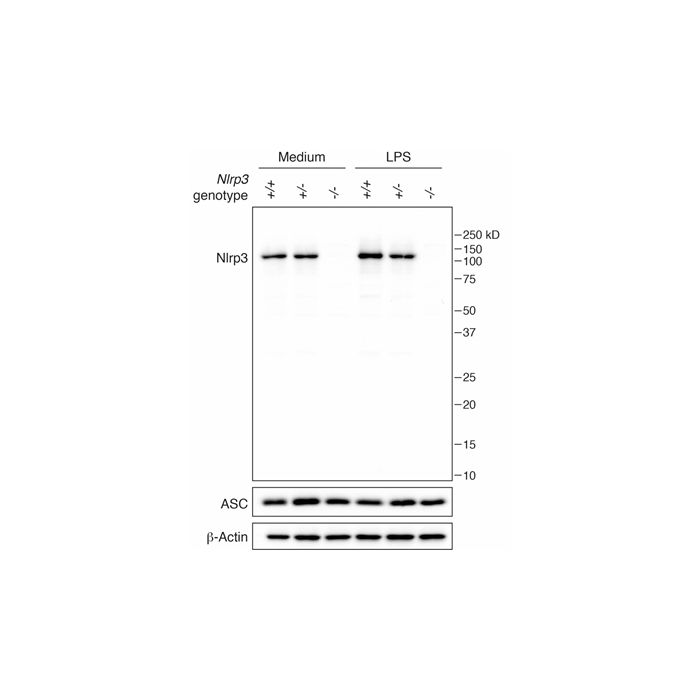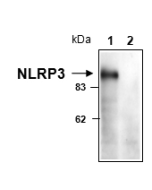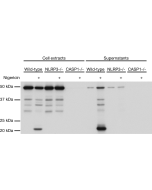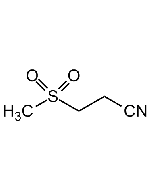Cookie Policy: This site uses cookies to improve your experience. You can find out more about our use of cookies in our Privacy Policy. By continuing to browse this site you agree to our use of cookies.
AdipoGen Life Sciences
anti-NLRP3/NALP3, mAb (Cryo-2)

| Product Details | |
|---|---|
| Synonyms | NACHT-, LRR- and PYD-containing Protein 3; NLRP3; Cryopyrin; Cold Autoinflammatory Syndrome 1 Protein |
| Product Type | Monoclonal Antibody |
| Properties | |
| Clone | Cryo-2 |
| Isotype | Mouse IgG2b |
| Source/Host | Purified from concentrated hybridoma tissue culture supernatant. |
| Immunogen/Antigen | Recombinant mouse NLRP3/NALP3 (pyrin domain/aa 1-93). |
| Application |
Western Blot (see online protocol): (1μg/ml) |
| Crossreactivity |
Human Mouse |
| Specificity |
Recognizes mouse and human NLRP3/NALP3. |
| Purity | ≥95% (SDS-PAGE) |
| Purity Detail | Protein G-affinity purified. |
| Concentration | 1mg/ml |
| Formulation | Liquid. In PBS containing 10% glycerol and 0.02% sodium azide. |
| Isotype Negative Control | |
| Other Product Data |
Tips for Western blotting: 1. NLRP3 is found only at low levels and the tissue or cells should express enough NLRP3. Therefore, the priming and activation steps are crucial for a successful Western blot and are often the reason why NLRP3 can not be detected properly. Please make sure that you have primed and activated the NLRP3 inflammasome properly. 2. The main band detected with the antibody Cryo-2 is migrating at about 110kDa. For high molecular weight proteins >100kDa such as NLRP3, it is best to transfer overnight following the tips described below. If the NLRP3 is not well transferred, then a longer exposure time is required and other non-specific bands can appear. A semi-dry blot is usually not recommended for proteins higher than 100kDa. We recommend using liquid transfer (wet tank) at 20V overnight to be sure that all NLRP3 has been transferred. Important, if markers are well transferred to the membrane, it does not mean that NLRP3 is transferred well too (markers are selected to be easily transferred also the High Molecular Weight Markers). For the NLRP3, it is best to apply the following tips: 3. We recommend using THP1 or BMDCs as a positive control and performing a 2nd antibody-alone control in parallel. |
| RRID | AB_2490202 |
| Shipping and Handling | |
| Shipping | BLUE ICE |
| Short Term Storage | +4°C |
| Long Term Storage | -20°C |
| Handling Advice |
After opening, prepare aliquots and store at -20°C. Avoid freeze/thaw cycles. |
| Use/Stability | Stable for at least 1 year after receipt when stored at -20°C. |
| Documents | |
| Protocols |
 Download PDF Download PDF |
| MSDS |
 Download PDF Download PDF |
| Product Specification Sheet | |
| Datasheet |
 Download PDF Download PDF |
The inflammasome is a multiprotein complex that mediates the activation of caspase-1, which promotes, amongst others, the secretion of the proinflammatory cytokines interleukin (IL)-1β and IL-18. Members of the Nod-like receptor family, including NLRP3/NALP3, are critical components of the inflammasome that link danger-signals to caspase-1 activation. Defects in NLRP3 are the cause of familial cold autoinflammatory syndrome type 1 (FCAS1), Muckle-Wells syndrome (MWS) and of chronic infantile neurologic cutaneous and articular syndrome (CINCA).
- Thioredoxin-interacting protein links oxidative stress to inflammasome activation: R. Zhou, et al.; Nature Immunology 11, 136 (2010)
- The NLRP3 inflammasome promotes renal inflammation and contributes to CKD: A. Vilaysane, et al.; J. Am. Soc. Nephrol. 21, 1732 (2010)
- A role for mitochondria in NLRP3 inflammasome activation: R. Zhou, et al.; Nature 469, 221 (2011)
- Differential expression of NLRP3 among hematopoietic cells: G. Guarda, et al.; J. Immunol. 186, 2529 (2011)
- Mechanism of Impaired NLRP3 Inflammasome Priming by Monophosphoryl Lipid A: C.A. Embry, et al.; Sci. Signal. 4, ra28 (2011)
- Measles Virus V Protein Inhibits NLRP3 Inflammasome-Mediated Interleukin-1 Secretion: N. Komune, et al.; J. Virol. 85, 13019 (2011)
- Novel role of PKR in inflammasome activation and HMGB1 release: B. Lu, et al.; Nature 488, 670 (2012)
- Deubiquitination of NLRP3 by BRCC3 Critically Regulates Inflammasome Activity: B.F. Py, et al.; Mol. Cell 49, 331 (2013)
- NLRP3 is activated in Alzheimer's disease and contributes to pathology in APP/PS1 mice: M.T. Heneka, et al.; Nature 493, 67 (2012)
- Activation of autophagy by inflammatory signals limits IL-1b production by targeting ubiquitinated inflammasomes for destruction: C.-S. Shi, et al.; Nat. Immunol. 13, 255 (2012)
- Inflammasome-independent NLRP3 augments TGF-β signaling in kidney epithelium: W. Wang, et al.; J. Immunol. 190, 1239 (2013)
- Omega-3 Fatty Acids Prevent Inflammation and Metabolic Disorder through Inhibition of NLRP3 Inflammasome Activation: Y. Yan, et al.; Immunity 38, 1154 (2013)
- LRRFIP2 negatively regulates NLRP3 inflammasome activation in macrophages by promoting Flightless-I-mediated caspase-1 inhibition: J. Jin, et al.; Nat. Commun. 4, 2075 (2013)
- Proapoptotic Chemotherapeutic Drugs Induce Noncanonical Processing and Release of IL-1β via Caspase-8 in Dendritic Cells: C. Antonopoulus, et al. J. Immunol. 191, 4789 (2013)
- Constitutively activated NLRP3 inflammasome causes inflammation and abnormal skeletal development in mice: S.L. Bonar, et al.; PLoS One 7, e35979 (2012)
- FADD and caspase-8 mediate priming and activation of the canonical and noncanonical Nlrp3 inflammasomes: P. Gurung, et al.; J. Immunol. 192, 1835 (2014)
- XIAP Restricts TNF- and RIP3-Dependent Cell Death and Inflammasome Activation: M. Yabal, et al.; Cell Rep. 7, 1796 (2014)
- The adaptor ASC has extracellular and 'prionoid' activities that propagate inflammation: B.S. Franklin, et al.; Nat. Immunol. 15, 727 (2014)
- The NLRP3 inflammasome is released as a particulate danger signal that amplifies the inflammatory response: A. Baroja-Mazo, et al.; Nat. Immunol. 15, 738 (2014)
- Toward a chemical marker for inflammatory disease: a fluorescent probe for membrane-localized thioredoxin: M.H. Lee, et al.; JACS 136, 8430 (2014)
- Prostaglandin E2 inhibits NLRP3 inflammasome activation through EP4 receptor and intracellular cyclic AMP in human macrophages: M. Sokolowska, et al.; J. Immunol. 194, 5472 (2015)
- The receptor NLRP3 is a transcriptional regulator of TH2 differentiation: M. Bruchard, et al.; Nat. Immunol. 16, 859 (2015)
- NLRP3 Inflammasome Is Expressed and Functional in Mouse Brain Microglia but Not in Astrocytes: A. Gustin, et al.; PLos One 10, e0130624 (2015)
- Nlrp6 promotes recovery after peripheral nerve injury independently of inflammasomes: E. Ydens, et al.; J. Neuroinfl. 12, 143 (2015)
- Human monocytes engage an alternative inflammasome pathway: M.M. Gaidt, et al.; Immunity 44, 833 (2016)
- Measuring NLR Oligomerization I: Size Exclusion Chromatography, Co-immunoprecipitation, and Cross-Linking: S. Khare, et al.; Methods Mol. Biol. 1417, 131 (2016)
- Functional Reconstruction of NLRs in HEK293 Cells: V. Compan & G. Lopez-Castejon; Methods Mol. Biol. 1417, 217 (2016)
- The NLRP3 inflammasome and bruton's tyrosine kinase in platelets co-regulate platelet activation, aggregation, and in vitro thrombus formation: P. Murthy, et al.; BBRC 483, 230 (2017)
- Pioglitazone Confers Neuroprotection Against Ischemia-Induced Pyroptosis due to its Inhibitory Effects on HMGB-1/RAGE and Rac1/ROS Pathway by Activating PPAR-γ: P. Xia, et al.; Cell Physiol. Biochem. 45, 2351 (2018)
- The Crohn’s disease risk factor IRGM limits NLRP3 inflammasome activation by impeding its assembly and by mediating its selective autophagy: S. Mehto, et al.; Mol. Cell 73, 429 (2019)
- HSP70 is a negative regulator of NLRP3 inflammasome activation: P. Martine, et al.; Cell Death Diff. 10, 256 (2019) [IF]
- Lack of Protein Prenylation Promotes Nlrp3 Inflammasome Assembly in Human Monocytes: O.P. Skinner, et al.; J. Allergy Clin. Immunol. 143, 2315(2019) [KO validation]
- Cathepsin B Is Required for NLRP3 Inflammasome Activation in Macrophages, Through NLRP3 Interaction: A. Chevriaux, et al.; Front. Cell. Dev. Biol. 8, 167 (2020)
- Caspase-6 Is a Key Regulator of Innate Immunity, Inflammasome Activation, and Host Defense: M. Zheng, et al.; Cell 181, 674 (2020)
- DDX3X coordinates host defense against influenza virus by activating the NLRP3 inflammasome and type I interferon response: S. Kesavardhana, et al.; J. Biol. Chem. 296, 100579 (2021)
- Oxidized DNA fragments exit mitochondria via mPTP- and VDAC-dependent channels to activate NLRP3 inflammasome and interferon signaling: H. Xian, et al.; Immunity 55, 1370 (2022)
- HSP90beta controls NLRP3 autoactivation: L. Spel, et al.; Sci. Adv. 10, eadj6289 (2024)
- Acute suppression of mitochondrial ATP production prevents apoptosis and provides an essential signal for NLRP3 inflammasome activation: B.S. Saller, et al.; Immunity 58, 90 (2025)
- The actin and microtubule network regulator WHAMM is identified as a key kidney disease risk gene: D. Mukhi, et al.; Cell Rep. 44, 115462 (2025)
- Type A cholesterol-dependent cytolysins translocate to the trans-Golgi network for NLRP3 inflammasome activation: N. Xiao, et al.; Nat. Immunol. 26, 1673 (2025)
- The NLRP6 inflammasome is activated by sterile or pathogen-induced endolysosomal damage: A. Boegli, et al.; EMBO J. (Epub ahead of print) (2025)










